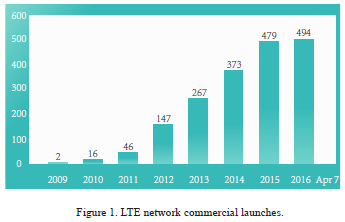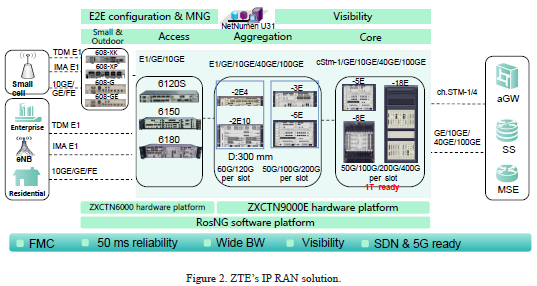Key Technologies of IP RAN

Based on dynamic IP/MPLS, an IP RAN network is built with packet-switched routers that can provide high bandwidth, high reliability, low delay, low cost, full services, and E2E QoS. IP RAN has become a mainstream networking solution for mobile backhaul. It is used to carry not only mobile voice and broadband multiservices to meet the need for 2G, 3G, and LTE/LTE-A base station access, but also carrier-class government and enterprise network services to satisfy operator needs for fixed mobile converged (FMC) full-service operation. Compared with traditional packet-switched networks, an IP RAN network introduces BFD, FRR, tunnel protection, and rapid route convergence technologies to ensure millisecond-level reliability, support IEEE 1588 and synchronous Ethernet, and meet the clock synchronization requirement of base stations and TDM traffic. The IP RAN network also simplifies service deployment through graphical E2E network management system. This guarantees large-scale networking and reduces O&M costs.
IP RAN Bearer
SDH/MSTP is used to bear traffic between 2G/3G base stations and a core network, where E1 interface rates are relatively low and the cost is high. As mobile broadband evolves to LTE and LTE-Advanced, it has been agreed in the industry that RAN must be IP-based, and packet mobile backhaul will be inevitable. LTE features all IP, multipoint-to-multipoint, high bandwidth, high reliability, low delay, and high-precision time synchronization. IP RAN has therefore become the primary choice for an operator's LTE mobile backhaul.

The Evolution to LTE report published by the Global Mobile Suppliers Association (GSA) in April 2016 confirmed that in190 countries around the world, 691 operators have launched and 26 operators are deploying LTE networks. This figure includes 494 operators that have commercially launched their LTE networks (Fig.1). It is estimated that 550 LTE networks will be put into commercial use at the end of 2016.
Because of insufficient resources, high cost, and difficulty in hardware maintenance, SDH/MSTP cannot satisfy the requirements for Ethernet-based high bandwidth and low cost of government and enterprise businesses. With widespread deployments of IP RAN, mobile operators are pressing to migrate their services from SDH/MSTP to IP RAN.
IP RAN Key Technologies
IP RAN carries 2G, 3G, and LTE/LTE-A mobile traffic that can meet the bearer needs of government and enterprise networks. To evolve to fixed and mobile convergence (FMC), IP RAN needs key technologies such as large-capacity routers, MPLS VPN-based multiservice bearer, high reliability, effective O&M, high-precision KPI measurement, clock synchronization, and QoS.
High-Capacity Routers
As radio networks evolve from 2G to 3G, LTE and 5G, base stations are more densely deployed. Especially in this mobile broadband era, a metropolitan area network (MAN) covers several hundreds of, thousands of, or even hundreds of thousands of base stations. In the LTE age, a single-eNodeB generally reaches a peak rate of over 100 Mbps, while in the LTE-A stage, the eNodeB that uses the carrier aggregation (CA) technology can reach a peak rate of up to 1 Gbps. In the 5G era, the peak rate can even reach 20 Gbps. Wide coverage, high density, and high bandwidth of radio networks impose higher requirements on bandwidth of bearer equipment.
The core IP RAN equipment is required to provide a switching capacity ranging from hundreds of Gbps to tens of Tbps, and a single slot is required to support a throughput of 100GE, 200GE, or 400GE. As chip technologies develop to meet 5G requirements, there is a pressing need for a single slot to support 10GE/40GE/100GE ports. With the research into ultra-100G technologies, higher-density ports will be supported in the future. In a flat network, core routers need to support high-density 10GE/40GE/100GE cards, and a single card needs to support more slots.
MPLS VPN-Based Multiservice Bearer
To migrate 2G, 3G, as well as government and enterprise network traffic from the original SDH/MSTP to IP RAN, it is necessary to provide E1, cStm-1, FE, GE, and 10 GE access capacity for carrying multiservices including 2G, 3G, LTE, LTE-A, and government and enterprise network services. MPLS has good QoS capability, supports point-to-point, point-to-multipoint, and multipoint-to-multipoint communication, and provides abundant service models. Therefore, adopting end-to-end MPLS technologies in backhaul IP RAN has become a consensus in the industry. A large IP RAN network can use VPN technologies such as MS-PW, HoVPN, OptionA, and seamless MPLS to improve its networking capability. The number of network nodes can be up to thousands or even hundreds of thousands.
High-Reliability
As IP RAN chiefly carries radio traffic as well as government and enterprise network services, millisecond-level carrier-class reliability has become the basic requirement. The high-reliability requirement of IP RAN includes fast fault awareness, fast forward switching, fast routing recovery, and BGP-PIC.
IP RAN detects faults through BFD that includes PW-BFD, IGP-BFD, BGP-BFD, peer-BFD, static route BFD, VRRP-BFD, PIM-BFD, LSP-BFD, and link-BFD. IP RAN also supports CFM detection. Continuity detection on the forwarding plane is based on hardware that can meet the requirement of millisecond-level failure switching. Some faults such as optical deterioration and link splitting can also be detected through CRC and EHT-LM. This triggers network switching, and the faults can be mapped through BFD and PW O&M-mapping.
The best way for fast traffic switching on the forwarding plane is to switch multiple redundant active/standby paths generated in advance by the forwarding table to other redundant paths for fast traffic recovery after fault detection. The related protection techniques involve smart-group, MC-LAG, MSP 1:1/1+1, PW-FRR, IP-FRR, r-LFA, LDP-FRR/ECMP, VPN-FRR/ECMP, hot-standby, TE-FRR, and VRRP. If these techniques are unavailable, it is necessary to adopt the routing/LSP convergence mechanism on the protocol layer. The prefix independent convergence (PIC) and the shortest path first (SPF) algorithm are used to refresh the next hop of relative routes via IGP and recover services in case of network failure. In this way, millisecond-level protection can also be achieved.
Effective O&M
An IP RAN network generally contains hundreds to thousands of nodes. If these nodes are all commissioned on site one by one manually, there would be a large amount of work. If traditional network management and O&M is used, services might be provisioned with low efficiency and maintained with difficulty.
An effective network O&M is therefore quite important. Equipment plug and play must be supported without the need of on-site manual commissioning. During service deployment, work orders are generated through E2E graphical user interfaces or special tools, and are automatically distributed through the network management system. During service O&M, services are viewed through a graphical network management system. This helps to improve visual O&M capability, rapidly locate faults, significantly enhance large-scale network maintenance, and reduce O&M costs.
Clock Synchronization
TDM services must be frequency synchronized, while 3G or LTE traffic requires high-precision phase synchronization. Synchronous Ethernet technology has been widely used in the industry. Synchronization at the physical layer can provide high frequency precision, ensure that E1 traffic restores frequency through a synchronous Ethernet, and implement accurate BIT stream transmission at a low error rate. The synchronous Ethernet plus 1588 v2 technology must also be supported to improve high-precision phase synchronization.
QoS
In the evolution from 2G/3G to LTE, more than 90% of radio sites are reused, and 2G/3G will coexist with LTE for a long term. IP RAN for government and enterprise networks has developed rapidly in recent years. In the future, FMC will be deeply developed. Transport networks must therefore meet the quality requirement for various service bearing. Multiservice convergence and bearing requires that IP RAN provide hierarchical QoS ability and ensure QoS of key services in case of network congestion.
There are two key requirements on QoS. One is to ensure that services with a higher QoS are first forwarded to reduce the delay. This is a traditional Differ-Serv concept. The other is to ensure that important services especially radio voice and critical government and enterprise network services are available in the event of network congestion. A bearer network must support hierarchical QoS processing and hierarchical queue scheduling for different base stations and services, so as to ensure important base stations never drop off.
SDN/5G Evolution
As the SDN technology is getting mature, manufacturers and operators have worked out their own SDN roadmaps. The introduction of SDN into IP RAN can simplify service deployment and reduce O&M costs. E2E service deployment and O&M can also be implemented easily in cross-domain scenarios. IP RAN uses dynamic IP/MPLS technology. At present, tenders of operators including Vodafone, AT&T, and China Telecom have specified that SDN IPRAN is based on the ODL architecture. In this architecture, southbound interfaces use BGP-LS, PCEP, and NETCONF protocols, and the equipment layer still keep IP/MPLS protocol to maintain network continuity. The deployment of RSVP-TE allows PCE to control service paths on the forwarding plane and thus provide IT-based northbound interfaces.
5G technical requirements have been well defined, and the work on 5G standardization will be finished in 2018. The key requirements for 5G backhaul networks include large-capacity switching equipment, ultra-100GE applications, 40GE/100GE networking at the access layer, 10GE (or as high as 25G) access ports on the eNodeB side, and cloud-based SDN for unified management of IP RAN and radio networks. In the 5G era, as the core network will move close to the user end and video services develop rapidly, the era of mobile distributed CDN will arrive. At that time, IP RAN will accommodate DCI technical requirements and eMBMS will further develop.
ZTE's IP RAN Solution
ZTE's IP RAN products cover ZXCTN 9000-18E/-8E/-5E/-3E/-2E10/-2E4 series serving as the IP RAN core for large, medium, small-sized radio access convergence, ZXCTN 6180/6150/6120S used for macrocells, indoor cells, and government and enterprise network service access to meet the needs of various ports, ZXCTN 608 used for outdoor and indoor access, and NetNumen U31 EMS used for visual and end-to-end effective operation and maintenance (Fig.2).

ZTE's IP RAN solution based on router technologies has powerful IP/MPLS capability and supports LSP (such as RSVTP-TE and LDP), MPLS VPN, and seamless MPLS. The solution also carries full services and provides high bandwidth, 50 millisecond-level carrier-class reliability, and visual E2E service configuration and management. Some operators have conducted lab tests on SDN IPRAN. ZTE's IP RAN solution has been widely deployed by China Telecom, China Unicom, and operators outside China.
Summary
For its high bandwidth, high reliability, low delay, low cost, full services, high-precision clock synchronization, and graphical O&M capability, IP RAN has become a mainstream bearer solution for radio backhaul networks. IP RAN is also evolutionary and can be used to carry radio voice, mobile broadband, and government and enterprise network services. It is agreed in the industry that IP RAN has gradually replaced traditional SDH/MSTP. Integrated fixed and mobile service bearing is a new trend for the development of IP RAN. Therefore, the evolution of IP RAN to SDN and 5G has become a research focus in the industry.